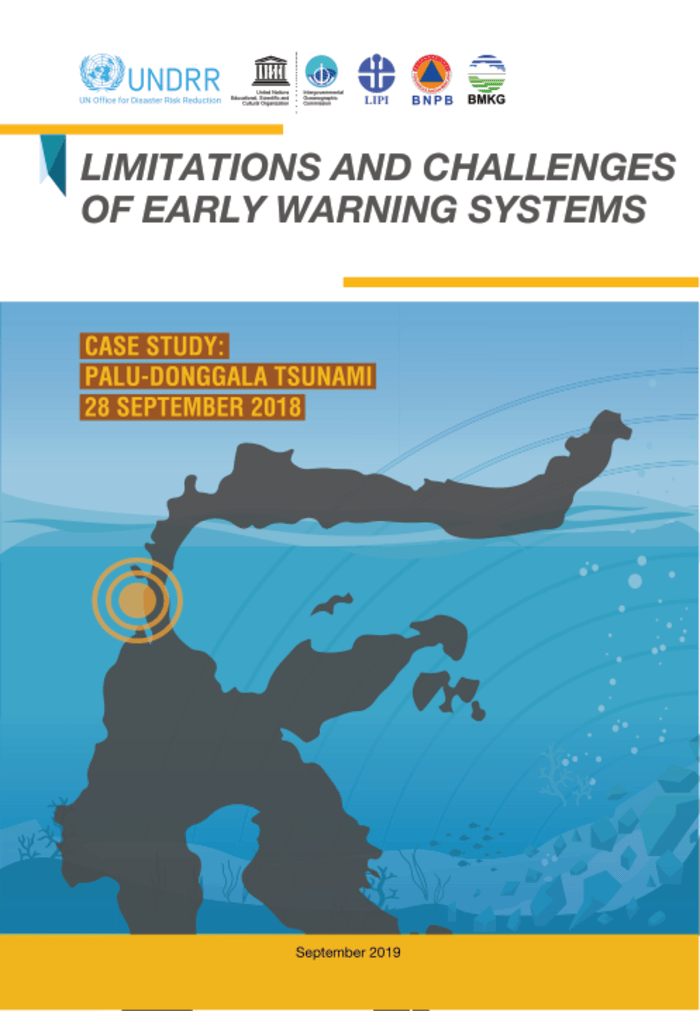Foreword
Located along the most seismically active zone in the world, Indonesia is no stranger to disasters, in particular, extreme weather events and natural hazards. On 28 September 2018, a tsunami struck Palu and Donggala. As the deadliest disaster in Indonesia and the world last year, its lessons should not be ignored.
Indonesia has demonstrated a strong commitment to disaster risk reduction over several decades, including through legislative and regulatory progress, national strategy development, early warning and risk information initiatives. The establishment of institutional and regulatory frameworks for risk reduction at the national and local level was marked by the 2007 adoption of Law Number 24 on Disaster Management, which saw the first shift from disaster management to risk management and the creation of National Disaster Management Authority. The Indonesian Tsunami Early Warning System has issued 22 early warnings since its launch in 2008, saving countless lives. Indonesia has a national strategy on disaster risk reduction, a solid understanding of its risk profile and is clearly acting to improve preparedness, resilient recovery and its ability to build-back-better and build to last.
Despite this progress, the tsunami of Palu and Donggala showed that significant challenges remain. Indeed, every time a destructive tsunami happens in the world, it is a wake-up call for countries to strengthen resilience, improve preparedness and deepen their understanding of risk.
This study, commissioned by the United Nations Office for Disaster Risk Reduction (UNDRR), is an evidence-based documentation of what happened during the event.
It captures the lessons learned and makes recommendations that can reduce the risk of potential future events.
What did go right? Early action on the part of community members, in carrying out evacuations based on past knowledge and public education, saved lives. Educational outreach and disaster simulation efforts must be expanded to increase public awareness and strengthen the ability of citizens to self-evacuate.
The findings also highlight the importance of not becoming too dependent on technology and the importance of building on community and indigenous knowledge. Indeed, the community should be the focus and the main subject of tsunami disaster risk reduction efforts. In the absence of community engagement to raise awareness and preparedness, over-reliance on technological solutions has the potential to create a false sense of security which contributes to complacency. Technological solutions need to be embedded in strong community engagement and outreach activities.
The study also found several areas for improvement; namely around the early warning system’s ability to detect tsunamis based on triggers outside the conventional scenarios, the level of infrastructure resilience as evident by the power and communication outages, and the level of risk awareness and preparedness at the community level.
Notably, the study shows that the end-to-end early warning system needs to be strengthened to effectively bridge the gaps between the upstream and downstream sides of the early warning chain to ensure timely community action. It is the “last mile” of communication that often determines the difference between life and death in the face of a disaster. It is only through bridging the last mile that we can ensure that no one is left behind.
The study reaffirms several of the recommendations discussed at the UNESCO-IOC International Conference to Commemorate the 10th Anniversary of the Indian Ocean Tsunami back in November 2014, and most recently, the UNESCO-IOC Symposium on Advances in Tsunami Warning to Enhance Community Responses in February 2018.
The study benefited from the insights shared at the Asia-Pacific Forum on Sustainable Development in March 2019, and at the Consultative Workshop on Strengthening Disaster Risk Reduction and Early Warning in Indonesia, in May 2019, where study findings were presented.
One of the goals of effective disaster risk reduction is to integrate knowledge into policy and plans to avoid future disasters. We hope governments, stakeholders, and communities throughout the region will incorporate study findings and recommendations into their risk mitigation and preparedness plans. We also hope this report will add value to the existing domain of knowledge on early warning systems and spark renewed interest in focusing on the social aspects of early warning and risk communication.
Nothing undermines development like disaster. Just as risk is evolving, so too must our risk reduction efforts. Disaster risk reduction is a continuous and dynamic process and we should always strive to make it better if we wish to leave no one behind and achieve resilience for all.
Lieutenant General Doni Monardo Head of the National Disaster Management Authority (BNPB)
Prof. Dr. Dwikorita Karnawati Head of the Meteorology,
Climatology and Geophysics Agency (BMKG)
Mami Mizutori UN Special Representative of the SecretaryGeneral for Disaster Risk Reduction
Vladimir Ryabinin Executive Secretary / Assistant Director-General UNESCO-IOC

